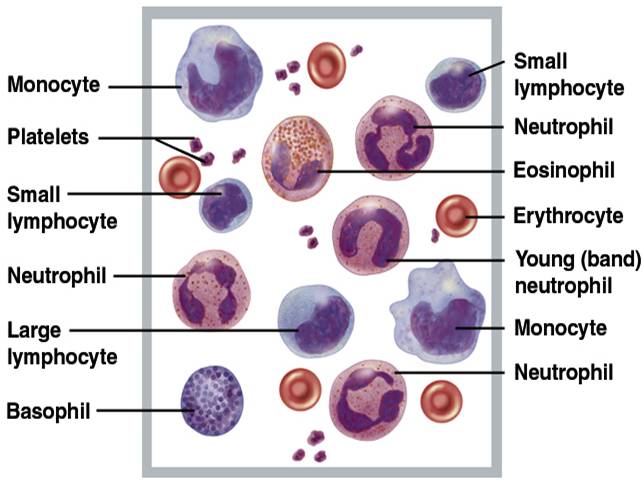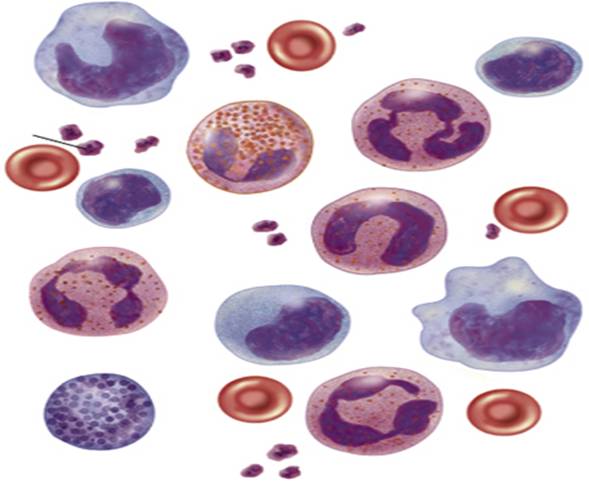White blood cells (WBC): White blood cells are an essential part of our immune system, and their unique appearances under a microscope provide valuable insights into our health. In this article, we’ll discuss the different types of WBCs, their distinct characteristics, and the significance of understanding their morphology. “White Blood Cell.” White blood cells are a crucial part of the immune system and play a vital role in protecting the body against infections and diseases. They help identify and fight off harmful pathogens such as bacteria, viruses, and other foreign substances.
Types of White Blood Cells
The white blood cells are agranulocytes and granulocytes each with distinct roles in our immune response:
Agranulocytes WBC are-
- Lymphocytes
- Monocytes
Granulocytes WBC are-
- Eosinophils
- Basophils
- Neutrophils
Lymphocytes
Lymphocytes are key players in adaptive immunity and come in two main types: B cells and T cells. They have a large, round nucleus and a small amount of cytoplasm. B cells produce antibodies, while T cells directly attack infected cells.

Monocytes
Monocytes are large cells with kidney-shaped nuclei. They can differentiate into macrophages when they enter tissues, serving as scavengers that engulf and digest debris, pathogens, and dead cells.
Neutrophils
Neutrophils are the most common type of WBCs and play a vital role in fighting bacterial infections. They appear as multi-lobed nuclei and have granules in their cytoplasm that contain enzymes for digesting pathogens.
Eosinophils
Eosinophils have bi-lobed nuclei and are involved in combating parasitic infections and allergic responses. Their granules contain substances that help neutralize parasites.
Basophils
Basophils are the least common WBCs and have large, S-shaped nuclei. They release histamine and other chemicals during allergic reactions, contributing to inflammation and immune responses.
Clinical Importance of WBC Morphology
Examining the morphology of WBCs provides valuable diagnostic information. Changes in cell size, shape, nucleus characteristics, and the presence of abnormal structures can indicate various medical conditions, such as infections, leukemia, and immune disorders.
Abnormalities of WBC
White blood cell (WBC) abnormalities refer to irregularities or deviations from the normal levels, types, or functions of white blood cells in the bloodstream. White blood cells, also known as leukocytes, play a crucial role in the immune system, defending the body against infections, pathogens, and foreign substances. Abnormalities in WBC count, distribution, or behavior can indicate various underlying health conditions. Here are some common WBC abnormalities:
- Leukocytosis: This refers to an elevated white blood cell count, often indicative of an active infection, inflammation, or a response to stress. Causes can include bacterial infections, inflammation, certain medications, and certain cancers.
- Leukopenia: Leukopenia is a lower than normal white blood cell count. It can be caused by various factors such as viral infections, certain medications, autoimmune disorders, and bone marrow disorders.
- Neutropenia: Neutropenia specifically refers to a reduced number of neutrophils, a type of white blood cell important for fighting bacterial infections. It can be caused by chemotherapy, certain medications, radiation therapy, and certain medical conditions.
- Neutrophilia: Neutrophilia is an elevated count of neutrophils. It can occur in response to bacterial infections, inflammation, stress, and certain cancers.
- Lymphocytosis: Lymphocytosis is an increased count of lymphocytes, another type of white blood cell. It can be a response to viral infections, certain types of leukemia, and some autoimmune disorders.
- Lymphopenia: Lymphopenia is a decreased count of lymphocytes. It can result from HIV/AIDS, certain medications, immune system disorders, and some viral infections.
- Monocytosis: Monocytosis refers to an elevated count of monocytes, a type of white blood cell involved in immune response and inflammation. It can occur due to chronic infections, inflammatory disorders, and certain cancers.
- Eosinophilia: Eosinophilia is an increased count of eosinophils. It can be associated with allergic reactions, parasitic infections, and certain autoimmune diseases.
- Basophilia: Basophilia is an elevated count of basophils, which play a role in allergic reactions and inflammatory responses. It is relatively rare and can be seen in conditions like chronic myeloid leukemia.
- Shift to the Left: A “shift to the left” refers to an increased number of immature white blood cells (bands) in the bloodstream. This can indicate a severe infection or other conditions that prompt the bone marrow to release immature cells prematurely.
It’s important to note that WBC abnormalities are often indicators of underlying health issues, and a thorough medical evaluation is needed to determine the cause and appropriate treatment. If you suspect any abnormalities in your white blood cell count or are experiencing symptoms related to your immune system, it’s advisable to consult a healthcare professional for proper diagnosis and management.
Conclusion
Understanding the morphology of white blood cells offers a window into our body’s immune response and overall health. By recognizing the distinct characteristics of different WBC types and identifying abnormalities, healthcare professionals can provide better patient care.
FAQs about WBC
1. Why is studying WBC morphology important?
WBC morphology provides insights into various health conditions, aiding in accurate diagnoses and appropriate treatments.
2. Can WBC morphology identify specific diseases?
A2: Yes, certain morphological features can suggest particular diseases, allowing for targeted investigations.
3. How is WBC morphology assessed?
WBC morphology is assessed by examining blood smears under a microscope, identifying cellular characteristics.





